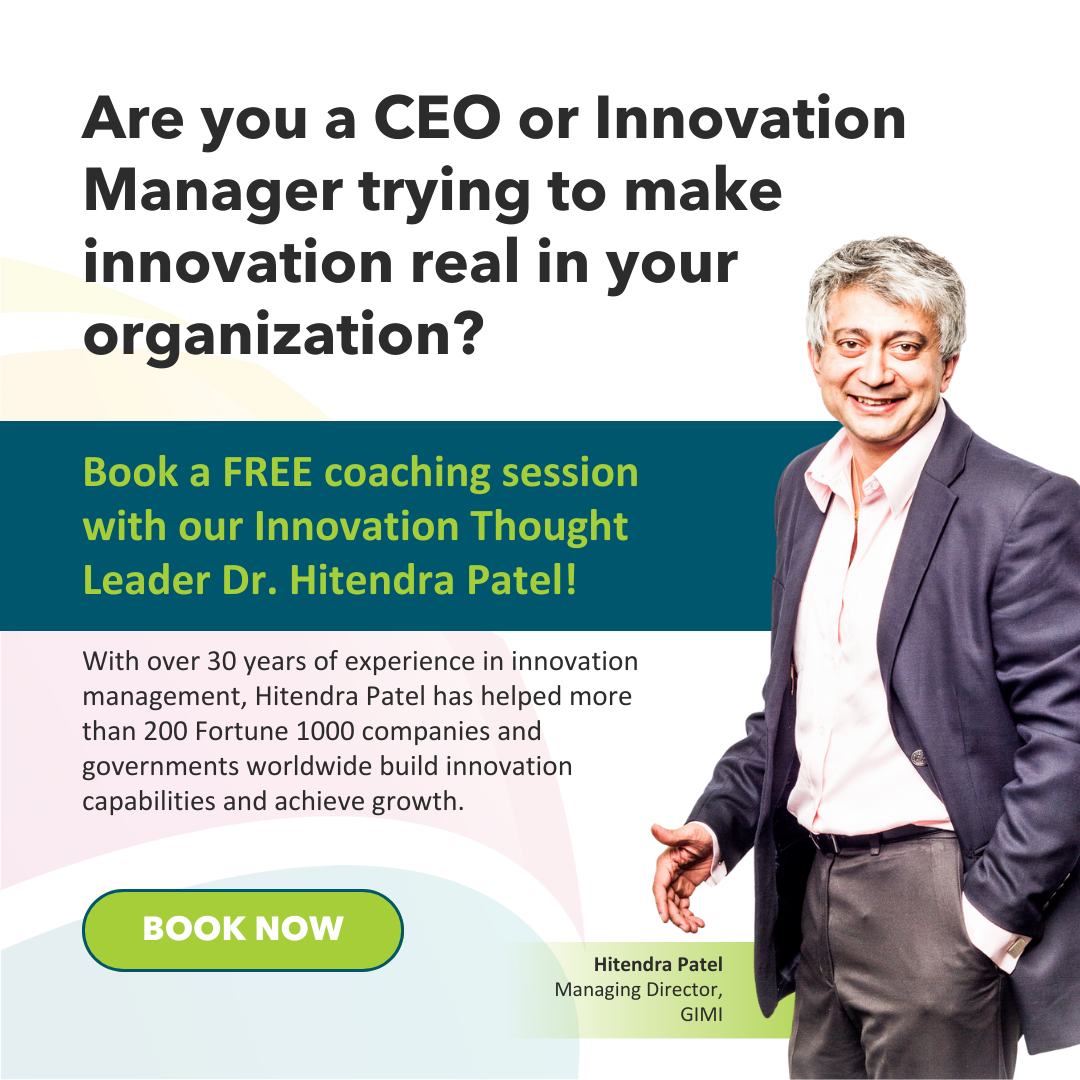What the most innovative organisations are doing to speed up innovation?
The Road To Innovation In The Middle East. Part 3
By: Carlos Guevara and Dr. Hitendra Patel, with special collaboration of Dr. Saeed Al Dhaheri, Sudarshan Chakravarthi, Lisa Nyman, and Anthony Denatale
“We asked our clients and experts for their recommendations for organisations trying to master the art of innovation. Here is what they answered.”
- Get your CEO excited about innovation
Ensure frequent informal meetings with the CEO and Chief Innovation Officer. These encounters create the optics that innovation is important, they facilitate decisions and support commitment to innovation. “We pay great attention to our Quarterly Global New Product Launch”, says Sudarshan Chakravarthi, Head of Marketing & Communications at 3M Gulf, about the mechanisms used by this innovation giant to put innovation at the centre of the top management’s agenda. “To make innovation happen, we need to make people believe in it”, says Anthony Denatale, Head of the Innovation Unit at DAFZA, who is leading a major cultural change in his organisation by raising innovation awareness levels, from CEO to floor employees.
- Create spaces to innovate
“At 3M we have the 15% rule, where we allow our employees to spend 15% of their work time on experimental doodling or experimental projects that could give way to new products”, says Sudarshan Chakravarthi, Head of Marketing & Communications at 3M Gulf. Innovative organisations encourage their employees to try and experiment on concepts that will drive the future of their businesses.
- Balance results and capacity building
Focusing on results is not sustainable, it only helps to keep the consultants hired, whereas focusing on capability building only results in lots of people, processes, and systems development. This only increases impatience from management, who believe that time and money are being squandered. The solution is finding the optimal balance between innovation results and capacity building. “At Ericsson we use a wide range of initiatives to keep innovation alive” says Lisa Nyman, Head of Strategy & Business Innovation at Ericsson
RMEA, whose company is investing heavily in certifying innovation coaches, has created innovation incentives, and also has recently established a Chief Innovation Officer role
commissioned as a disruptive force to further augment and accelerate innovation via incubation and venture funding.
- Focusing on BIG ideas
Big ideas are exciting for managers, employees, suppliers, partners, and customers. Big Ideas move the needle on business results. “Focus on game-changing initiatives has to be the starting point… companies mistakenly use six-sigma, TQM or lean management tools for driving breakthrough business growth. These tools are for process improvement, cost reduction, increased predictability, exactly the opposite of innovation”, says Dr. Hitendra Patel at the IXL Center for Innovation.
- Embrace the digital forces
Most of the clients and experts agree that digital forces are about to disrupt the world as we know it. Some industries will feel this stronger than others. Pioneer organisations are currently developing digital capabilities to be the disrupters, rather than being disrupted.
- Customer-centric innovation
Pioneer organisations place the customer at the centre of their innovation process, then iterate, connect and disconnect ideas until they find a unique space in which they can add value. “An example is the Adhesive platform in 3M; it goes from a simple Scotch Tape
which can hold the back side of an envelope, all the way up to Scotch solutions raising an 800 kilo car in Germany off a crane”, says Sudarshan Chakravarthi, Head of Marketing & communications at 3M Gulf.
- Fail…fast and cheap
Failing fast and cheap is not a new concept, but many organisations are still reluctant to endorse failure of any kind. “One way to overcome this is to use the Lean Startup method,
which focuses on reducing the upfront investment and thus the risk by creating a Minimum Viable Product (“MVP”) to be tested in the market, and based on the customer response
pivot or persevere. Another option is to work closer with customers and partners and thus share the risk and potential return”, says Lisa Nyman, Head of Strategy & Business Innovation at Ericsson RMEA. Companies like Google and 3M encourage innovation time among all their employees. Failure does not need to be expensive. Neither should it lead to career risk.
Lessons from the largest SME accelerator in the world
By Dr. Hitendra Patel – IXL Center for Innovation and Project Leader of Colombia’s 10x SME Accelerator – Colciencias
Google created Alphabet because its founders were concerned that the company had become too big and it had stopped innovating. Innovation is typically associated with startups and SMEs, but startups face many challenges as they navigate the infantry stage. But what about SMEs? Could SMEs hold the magic formula to nurture innovation?
SMEs have a higher success rate with new ideas to commercialization than startups or large companies. In startups, the CEO is not a proven businessman or manager; and in large companies inputs and decisions are distributed across the organisation, slowing down or even stopping innovation. In SMEs, the CEO already knows how to buy, make and sell, hire and fire, and navigate complexity while in a startup the CEO is still learning. In SMEs, the CEO is often present in innovation meetings and decisions are made at the moment, and so are resource allocations; while in big companies the CEO delegates responsibilities and is not present.
Innovations pursued by SMEs are oftentimes me-too products but offered with a better value proposition along the value chain of an existing company. SMEs unlock value by innovating these inefficiencies. The impact of innovation growth in SMEs is significant, as it creates accelerated growth compared to big corporations.
About Colciencias: 10x SME program in Colombia has promoted regional economic growth by building innovation capacity at hundreds of small enterprises. Delivered in cooperation with the Colombian National Administrative Department of Science, Technology and Innovation (Colciencias) and five metropolitan governments, it guides companies from idea to purchase order.
Public Sector Case Study – The UAE Journey Towards Innovation
Interview with Dr Saeed Al Dhaheri – Chairman of Smartworld and Advisor to several UAE government Entities
Can you provide a brief history of innovation in the UAE government and why it is so important today?
Innovation in UAE government can be traced back to 1997, with the establishment of the first Dubai Government Excellence Program DGEP, followed in 2009 by Abu Dhabi Award for Excellence in Government Performance, and in 2010 by the Federal Government – Sheikh Khalifa Government Excellence Program. These programs emphasised innovation as a necessary ingredient for government excellence.
In 2015, the UAE government launched the ‘National Innovation Strategy’, emphasising innovation in government as a cornerstone for social and economic development and key for increasing UAE competitiveness, providing new job opportunities, and improving the overall quality of life and happiness of people.
The 4th cycle of UAE government excellence model adopted in 2016 is now emphasising innovation as an enabler, and giving 20% weight in the evaluation of innovation management practices in government organisations. The Initiative for Government Innovation (IBDAA) has now four innovation categories: the most innovative government department, the most creative idea, the most creative government employee and the most creative government leader. These innovation programs have significantly helped instill a good innovation culture and practices in UAE government entities.
What are the most common challenges that government entities face when it comes to innovation?
The Innovation climate in UAE government is becoming more and more visible as innovation is supported and championed by leadership on many levels of government, and exercised in almost all of government entities.
Yet, there exist some challenges including insufficient allocated budgets to implement the accepted creative ideas coming through ideation systems. This can result in delaying the implementation of good ideas, which slows down innovation pace, or sometimes renders those ideas irrelevant if not implemented on time.
Providing and linking incentives to performance of staff is another challenge that government entities are facing. Without proper incentives, recognition, and reward for staff efforts to innovate, employees tend to lose momentum and passion, and become discouraged to come up with creative ideas or solutions.
Last but not least, organisations struggle with creating a risk environment that nurtures new ventures. Innovation requires experimentation and risk taking. If the environment does not allow employees to experiment and try new things with acceptable risk of failure, they will be afraid to test and try different approaches/ways to implement their ideas, which will stifle innovation.
What would you recommend to a government entity embarking in the journey of innovation?
Government entities should establish innovation strategies, link them to their organisational strategy, and ensure to have a clear innovation process that should be reviewed and assessed from time to time.
Adopting agile mindset and agile practices such as agile software development framework is of importance to government entities to be responsive to changes and for their provision of new innovative services.
Innovation is more about collaboration; internal collaboration within the organisation and external collaboration with customers and other stakeholders. Government entities need to capitalise on innovation technology to make collaboration possible.





